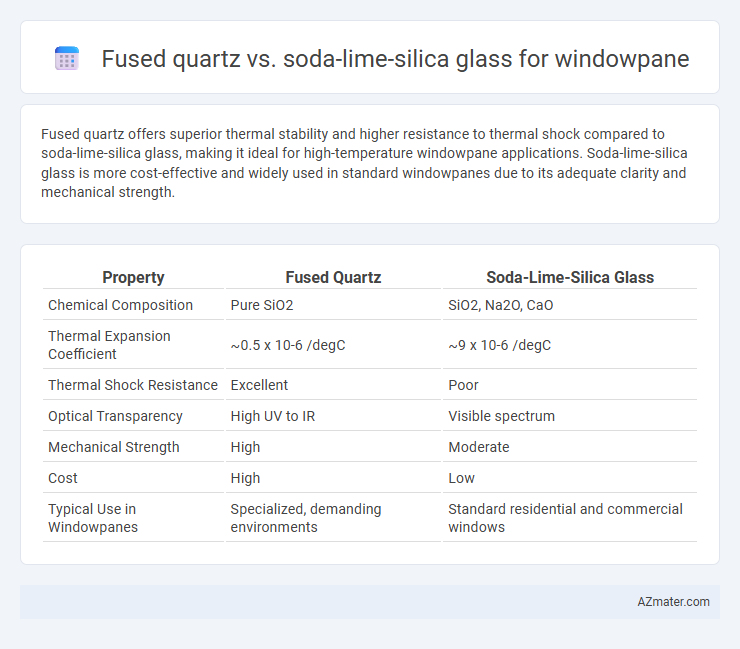Fused quartz offers superior thermal stability and higher resistance to thermal shock compared to soda-lime-silica glass, making it ideal for high-temperature windowpane applications. Soda-lime-silica glass is more cost-effective and widely used in standard windowpanes due to its adequate clarity and mechanical strength.
Table of Comparison
| Property | Fused Quartz | Soda-Lime-Silica Glass |
|---|---|---|
| Chemical Composition | Pure SiO2 | SiO2, Na2O, CaO |
| Thermal Expansion Coefficient | ~0.5 x 10-6 /degC | ~9 x 10-6 /degC |
| Thermal Shock Resistance | Excellent | Poor |
| Optical Transparency | High UV to IR | Visible spectrum |
| Mechanical Strength | High | Moderate |
| Cost | High | Low |
| Typical Use in Windowpanes | Specialized, demanding environments | Standard residential and commercial windows |
Composition Overview: Fused Quartz vs Soda-Lime-Silica Glass
Fused quartz is primarily composed of nearly pure silicon dioxide (SiO2) with minimal impurities, offering exceptional thermal stability and optical clarity. Soda-lime-silica glass consists mainly of silicon dioxide combined with sodium oxide (Na2O) and calcium oxide (CaO), providing cost-effective manufacture and good mechanical strength but lower thermal resistance. The distinct compositional differences impact their performance in windowpanes, where fused quartz excels in high-temperature and high-purity applications, while soda-lime-silica glass suits standard architectural use.
Optical Clarity and Light Transmission
Fused quartz offers superior optical clarity and higher light transmission compared to soda-lime-silica glass, making it ideal for applications requiring minimal distortion and maximum transparency. The low impurities and uniform molecular structure of fused quartz result in excellent ultraviolet and visible light transmission, often exceeding 90%, while soda-lime-silica glass typically transmits around 80-85%. Its high thermal resistance and low thermal expansion further preserve optical performance under fluctuating temperatures, unlike soda-lime-silica which may suffer from haze and reduced clarity.
Thermal Resistance and Temperature Tolerance
Fused quartz exhibits exceptional thermal resistance and can withstand temperatures up to 1650degC without deformation, making it ideal for high-temperature applications in windowpanes. Soda-lime-silica glass typically tolerates temperatures up to 600degC, but it softens and deforms at lower temperatures compared to fused quartz. The high purity and low thermal expansion coefficient of fused quartz result in superior temperature tolerance and thermal shock resistance compared to soda-lime-silica glass.
Mechanical Strength and Durability
Fused quartz exhibits superior mechanical strength and durability compared to soda-lime-silica glass, with a higher tensile strength around 40-50 MPa and excellent resistance to thermal shock due to its low coefficient of thermal expansion (0.5 x 10^-6 /degC). Soda-lime-silica glass, commonly used in windowpanes, has tensile strengths around 30-50 MPa but is more prone to mechanical stress and thermal cracking under temperature fluctuations. The enhanced durability and fracture resistance of fused quartz make it ideal for high-performance window applications requiring long-term structural integrity.
Chemical Resistance and Corrosion
Fused quartz exhibits superior chemical resistance and corrosion resistance compared to soda-lime-silica glass due to its high purity and nearly inert silicon dioxide composition. Soda-lime-silica glass is more prone to chemical attack and surface degradation when exposed to acidic or alkaline environments, leading to potential clouding or etching over time. Fused quartz maintains clarity and structural integrity in harsh chemical conditions, making it ideal for windows in industrial or laboratory settings where corrosion resistance is critical.
Cost Comparison and Economic Considerations
Fused quartz typically incurs higher upfront costs compared to soda-lime-silica glass due to its raw material purity and complex manufacturing processes, impacting budget-sensitive windowpane projects. Soda-lime-silica glass offers an economically viable solution with lower production expenses and widespread availability, making it the preferred choice for standard window applications. Evaluating long-term durability and thermal resistance, fused quartz may justify its initial investment in specialized settings where performance outweighs material cost.
Manufacturing Processes and Availability
Fused quartz is produced through melting high-purity silica sand at temperatures exceeding 2000degC, resulting in exceptional thermal stability and low thermal expansion, but its manufacturing process is energy-intensive and costly. Soda-lime-silica glass is made by melting a mixture of silica sand, soda ash, and limestone at approximately 1500degC, offering ease of production and widespread availability due to its lower melting point and well-established industrial processes. The widespread manufacturing infrastructure for soda-lime-silica glass ensures its mass production and affordability, while fused quartz remains a specialized product with limited availability primarily reserved for high-performance applications.
Applications in Windowpane Design
Fused quartz offers superior thermal resistance and optical clarity compared to soda-lime-silica glass, making it ideal for high-performance windowpanes in extreme temperature environments and scientific applications. Soda-lime-silica glass, favored for its cost-effectiveness and ease of manufacturing, is the predominant choice for standard residential and commercial windowpanes. The enhanced durability and low thermal expansion of fused quartz contribute significantly to energy-efficient and long-lasting architectural designs.
Environmental Impact and Sustainability
Fused quartz offers superior environmental benefits compared to soda-lime-silica glass due to its lower energy consumption during production and exceptional durability, which reduces the frequency of replacement and waste generation. Soda-lime-silica glass, while more commonly used, involves higher carbon emissions in manufacturing and has a shorter lifespan, leading to increased environmental impact over time. Choosing fused quartz for windowpanes enhances sustainability through its recyclability and resistance to thermal stress, minimizing resource depletion and ecological footprint.
Choosing the Right Glass: Key Takeaways
Fused quartz offers exceptional thermal stability and superior resistance to UV radiation compared to soda-lime-silica glass, making it ideal for high-temperature or harsh environmental conditions. Soda-lime-silica glass remains the most cost-effective option for standard windowpanes due to its good mechanical strength and clarity. Selecting the right glass depends on balancing factors such as durability, thermal performance, clarity, and budget constraints.

Infographic: Fused quartz vs Soda-lime-silica glass for Windowpane
 azmater.com
azmater.com